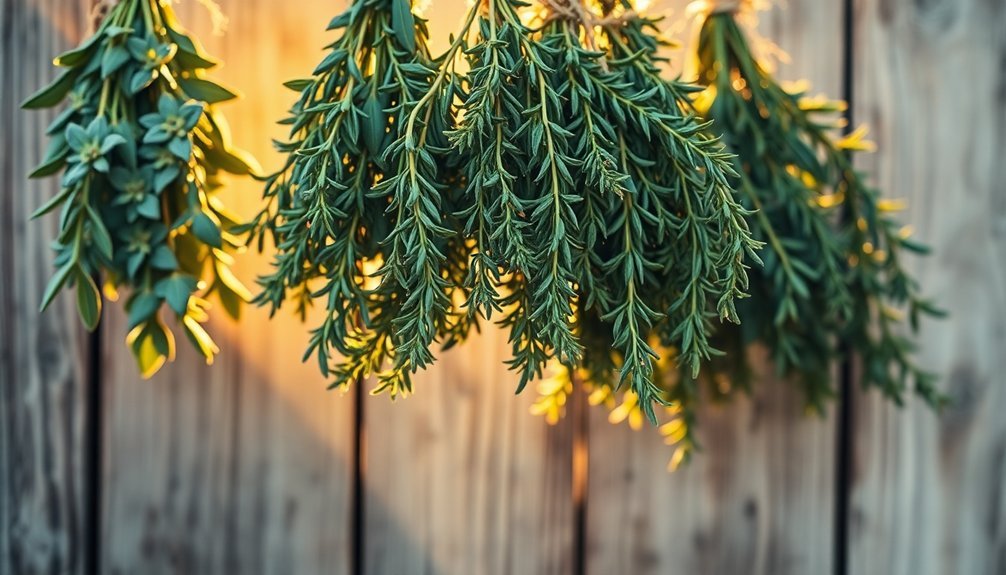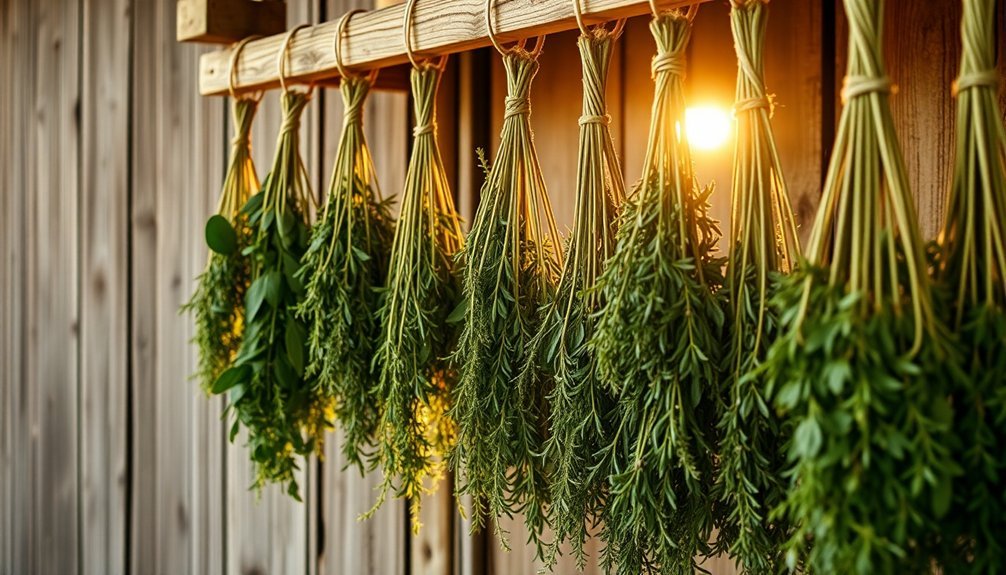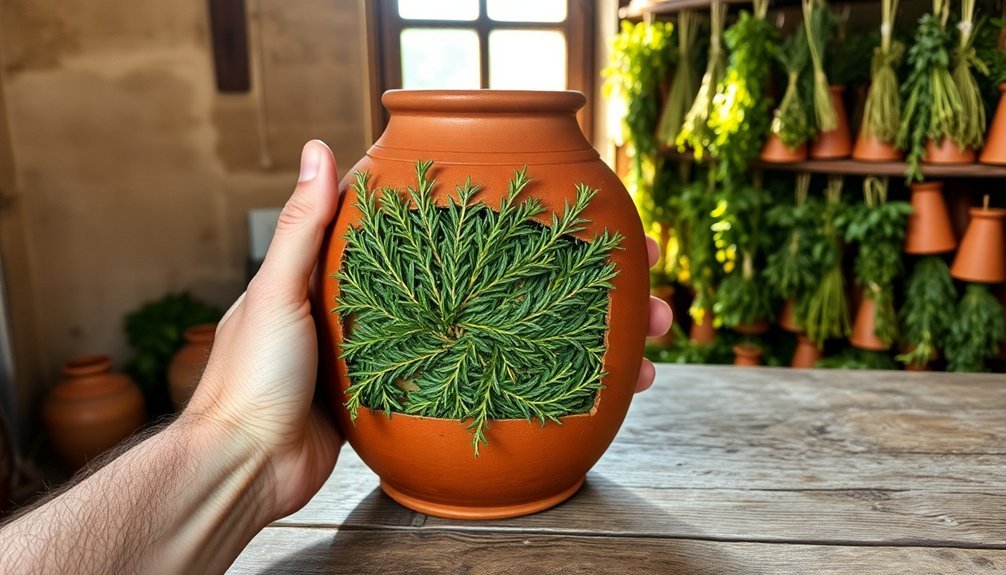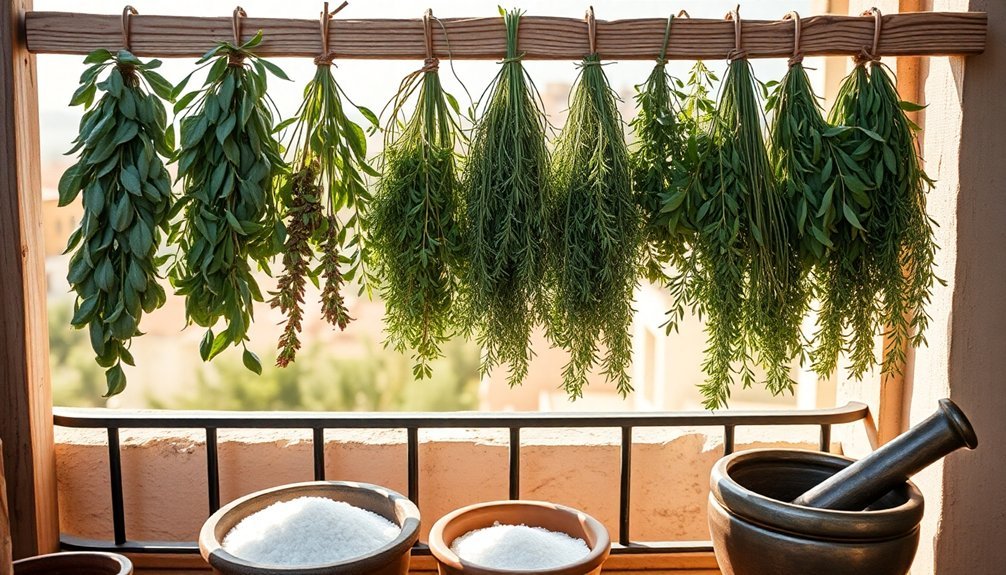You'll preserve sun-dried herbs for generations by following time-tested methods that date back 12,000 years. Start by harvesting herbs in early morning after the dew dries, when essential oils are most concentrated. Keep your drying temperature between 95°F and 115°F, with humidity below 60% in a well-ventilated, shaded area. Store your dried herbs in airtight glass or ceramic containers, never plastic, and label them with the date and type. Regular monitoring for moisture and proper storage away from other foods guarantees your herbs maintain their potency. The ancient wisdom behind these preservation techniques holds even more secrets to reveal.
Ancient Sun-Drying Wisdom

Preserving herbs through sun-drying stands as one of humanity's oldest food preservation techniques, dating back to 12,000 B.C. in the Middle East and Orient. Ancient civilizations in Mesopotamia and Egypt mastered this method, which became essential for survival before the advent of modern refrigeration.
You'll find that these time-tested techniques weren't just about preservation; they were deeply woven into the social fabric of communities. These practices often led to vibrant marketplaces where dried goods were traded and celebrated.
When you look at traditional methods, you'll discover that herbs were carefully spread on sun-warmed stones and wooden slats, while in regions with less sunlight, people developed "still houses" heated by fire.
You can still see these practices today, as many herbalists continue to hang bundles upside down to dry, just as their ancestors did. If you're following these ancient techniques, you'll want to protect your herbs from direct sunlight to maintain their potency and color.
What's remarkable is that these methods haven't just survived; they've proven their worth across millennia.
They've created a lasting connection to the land and continue to influence how we preserve herbs today, demonstrating that sometimes the oldest solutions are the most effective.
Optimal Harvest Time
You'll want to head out to your herb garden in the early morning hours, just after the dew has dried but before the day's heat sets in, to capture the highest concentration of essential oils.
Avoid harvesting during intense midday temperatures as this can significantly degrade the herbs' quality.
Ancient wisdom and modern research agree that spring and early summer offer the best seasonal window for gathering most herbs, especially when flower buds are beginning to form but haven't yet opened.
For mint specifically, break from this timing rule and harvest during full bloom, when its aromatic oils reach their peak.
Early Dawn Collection
The golden hours of early dawn provide the perfect window for harvesting herbs at their peak potency. You'll want to wait until the morning dew has evaporated but before the day's heat intensifies. This timing guarantees you're capturing the herbs' essential oils and flavors at their most concentrated levels. Small space gardens are perfectly suitable for growing herbs for drying.
To maximize your harvest's quality, you'll need to identify the ideal growth stage. Look for herbs that are just about to flower, when they're in their bursting bud stage. This is when the plants contain their highest concentration of aromatic oils and beneficial compounds. You don't want to wait until they've fully flowered, as this can reduce leaf production and overall flavor.
When you're collecting your herbs, handle them with care to prevent bruising or damage. Remove any yellowed, damaged, or soiled parts immediately. If you need to clean your harvest, use cool water and guarantee proper ventilation.
Keep your collected herbs away from direct sunlight and excessive heat during the harvesting process. Proper air circulation is essential, so choose a well-ventilated area for your initial collection and sorting.
Ancient Seasonal Wisdom
Ancient wisdom passed down through generations reveals that every season offers unique opportunities for herb harvesting.
You'll find that spring is ideal for collecting leafy herbs like mint, basil, and parsley when they're bursting with fresh growth, but you'll want to avoid root harvesting during this time as plants need their stored energy.
In summer, you'll focus on leafy matter and flowers at their peak bloom. It's crucial to harvest herbs like oregano and basil regularly to encourage continued growth, but don't over-harvest – use clean garden snips to protect the plants.
When fall arrives, you'll shift your attention to roots, seeds, and berries. This is when you'll gather roots from plants like ginger and burdock, as they're entering their dormant phase.
Winter doesn't mean you'll stop harvesting completely. You can collect rose hips, nannyberry, and conifer needles during the cold months.
It's also the perfect time to use your stored herbs and focus on warm seasonal spices. You'll find that understanding these seasonal rhythms guarantees your herbs retain their maximum potency and medicinal properties.
Solar Heat Preservation Methods

You'll get the best results drying herbs in temperatures around 100°F while keeping them out of direct sunlight to prevent leaf bleaching.
To set up your drying station, place stackable screens with a glass top in a shaded area, making sure there's proper ventilation to maintain airflow and prevent moisture buildup.
Monitor the temperature throughout the day, bringing your herbs indoors at night to protect them from excess humidity and maintain consistent drying conditions.
Effective Sun Exposure Times
Successfully drying herbs out in the sun requires careful attention to timing and exposure conditions. You'll need temperatures above 85°F (29°C) and humidity levels below 60% for ideal results. Your herbs will typically dry within hours to several days, depending on the specific variety and weather conditions.
To protect your herbs during the drying process, you'll want to use muslin or mesh produce bags with adequate ventilation. Don't expose them to direct sunlight without protection – an 85% shade cloth will prevent UV damage while still allowing sufficient heat penetration.
You'll know your herbs are properly dried when they become brittle to the touch.
Remember to bring your herbs indoors each night to prevent moisture accumulation, and check them regularly throughout the drying process to prevent overdrying.
Once they're dried, you'll need to heat them in an oven at 160°F for 10 minutes to eliminate any insects or eggs. After cooling, store your herbs whole in dark glass jars or tins, crushing them only when you're ready to use them. This preservation method helps retain the essential oils that give your herbs their distinctive flavors and properties.
Traditional Drying Rack Setup
Setting up a traditional drying rack involves three essential components: proper materials, strategic placement, and adequate ventilation control.
You'll need to start by gathering twine or rubber bands to secure your herb bunches, along with screens or mesh bags for individual leaves. Consider using embroidery hoops or collapsible racks as your main hanging structure.
Position your drying rack in a dimly lit, cool area away from your kitchen, where excess moisture and heat can compromise the herbs' quality. You'll want to guarantee proper spacing between herb bundles to maximize air circulation.
If you're using a passive solar drying shed, incorporate metal or PVC hoops covered with greenhouse plastic and landscape fabric to regulate both airflow and UV exposure.
You'll need to monitor your herbs regularly throughout the drying process. As the stems shrink, use twist-ties to maintain tight bundles.
Your herbs are ready for storage when they feel brittle to the touch. Remember to check frequently for any signs of mold or over-drying, and adjust your setup accordingly.
Once dried, transfer your herbs promptly to airtight containers to maintain their potency and freshness.
Temperature Control Methods
Through careful temperature management, solar drying of herbs requires specific methods to preserve their essential properties. You'll need to maintain temperatures between 95°F and 115°F, though you might need to increase it to 125°F in high-humidity areas.
To achieve these conditions, you can use light-protected drying chambers that prevent direct sunlight exposure while allowing even airflow distribution.
For maximum temperature control, you'll want to incorporate shade cloth that blocks at least 85% of UV rays in passive solar drying sheds. These structures work best when equipped with proper ventilation systems and collapsible drying racks.
If you're using a solar dehydrator, look for conditions around 100°F with 60% humidity or less. You can create this environment using drying screens or DIY dehydrators with glass tops and absorber plates.
To maintain consistent temperatures, you'll need to monitor your herbs frequently and adjust your setup accordingly.
Don't forget to bring your herbs indoors at night to protect them from moisture. Use stainless steel sieves and air filters in your drying chambers to guarantee hygienic conditions while maintaining proper air circulation.
Proper Storage Vessel Selection
Your dried herbs' longevity depends heavily on choosing the right storage containers. For ideal preservation, you'll want to select airtight glass jars or ceramic vessels that protect your herbs from light deterioration.
While there are several container options available, it's essential to avoid plastic containers as they can leach unwanted chemicals into your precious herbs.
Before storing your herbs, make certain your chosen containers are completely dry and clean to prevent mold growth. You'll need to label each container with the herb type and preservation date, which helps you maintain a proper rotation system.
Fill the containers in a way that minimizes air exposure, and seal them tightly to maintain airtight conditions.
To maintain your stored herbs' quality, you'll need to check your containers regularly for any signs of moisture or spoilage. Keep them away from other foods to prevent flavor transfer, and avoid exposing them to extreme temperature changes.
If you're using metal containers, verify they're vapor-proof to prevent moisture absorption. For freezer storage, use proper freezer jars but be cautious of condensation formation, which can compromise your herbs' quality.
Climate and Environmental Factors

Successful herb drying requires careful attention to climate and environmental conditions in your workspace.
You'll need to maintain humidity levels between 45-55 percent to prevent mold formation and preserve your herbs' quality. If you're in a high-humidity area like the Pacific Northwest, where levels often exceed 60 percent, you'll want to use additional ventilation methods.
Proper air circulation is essential for your drying success. Set up an oscillating fan to maintain consistent airflow, which helps prevent mold growth and guarantees even drying throughout your herbs.
You'll want to keep temperatures between 70° and 90° – this range is ideal for preserving essential oils while effectively drying your herbs.
Don't expose your herbs to direct light during the drying process. Light exposure can greatly degrade their medicinal properties, flavor, and color.
Instead, choose a dark or shaded area for both drying and storage. When you're setting up your drying space, remember that consistent temperatures, proper ventilation, controlled humidity, and minimal light exposure work together to maintain your herbs' potency and extend their shelf life.
Cultural Preservation Practices
Beyond the technical aspects of herb drying, sun-drying practices carry deep cultural significance that spans millennia. You'll find these traditions deeply rooted in ancient civilizations, from Mesopotamia around 4000 BC to the settlements of Native American tribes and Spanish colonists in Texas.
When you participate in sun-drying herbs today, you're connecting with customs that have strengthened community bonds for generations. These practices aren't just about food preservation; they're about maintaining cultural identity through shared knowledge and experiences.
You'll often see this heritage celebrated in festivals and community gatherings, where families come together to preserve herbs using time-honored methods. You can still witness the educational aspect of these traditions through workshops and community programs that teach ancient preservation techniques.
It's a living practice where you'll learn from those who've inherited generations of expertise. Today's revival of sun-drying aligns perfectly with modern sustainability goals while honoring ancestral wisdom.
When you preserve herbs through sun-drying, you're not just storing food – you're participating in a cultural practice that's been connecting communities and celebrating seasonal abundance for thousands of years.
Quality Control Through Generations

Quality control's evolution in herb drying reflects generations of accumulated wisdom and modern scientific understanding. You'll find that today's best practices combine traditional knowledge with scientific methods to guarantee herbs maintain their potency and safety.
When you're harvesting, you'll need to use clean baskets and avoid ground contact to prevent contamination. You shouldn't use raw manure as fertilizer, and you'll want to train all workers in proper hygiene practices.
After harvesting, it's essential to wash herbs quickly using chlorinated water, but you'll need to monitor chlorine levels carefully to prevent flavor changes.
Despite traditional practices, you shouldn't rely on sun drying, as it can degrade your herbs' quality. Instead, you'll want to use controlled air drying with good ventilation or modern dehydrators. You can improve drying efficiency through pre-treatments like blanching or ultrasonic treatment.
For storage, you'll need airtight, opaque containers placed in cool, dry areas. Don't forget to label and date everything, and always store containers off the ground on wooden pallets.
Seasonal Drying Cycles
The mastery of seasonal drying cycles builds directly on proper quality control practices. You'll need to time your harvests carefully, focusing on the morning hours after dew has dried but before the heat intensifies. For best results, collect leafy herbs just before flowering, while woodier varieties like rosemary can be harvested throughout the season.
| Season | Best Practices |
|---|---|
| Spring | Harvest new growth after morning dew evaporates; focus on tender herbs |
| Summer | Pick herbs just before flowering; use indoor drying methods to avoid sun damage |
| Fall | Collect seeds when pods change color; gather roots as plants enter dormancy |
| Winter | Continue root harvesting; maintain indoor drying areas with good ventilation |
| Year-round | Store in airtight containers away from heat and light |
Your drying environment matters greatly. Always choose a cool, dry space with good air circulation, avoiding direct sunlight that can degrade both flavor and color. While sun drying might seem traditional, it's actually one of the least effective methods. Instead, rely on air drying for herbs like thyme and sage, or use a dehydrator for precise control over temperature and airflow.
Frequently Asked Questions
Can Sun-Dried Herbs Be Used in Modern Medicine and Pharmaceutical Production?
Yes, you can use sun-dried herbs in modern medicine and pharmaceuticals because they retain essential bioactive compounds, antioxidants, and antimicrobial properties. They're particularly effective when dried using controlled solar drying methods.
How Do Different Altitudes Affect the Sun-Drying Process of Herbs?
At higher altitudes, you'll find herbs dry faster due to lower air pressure and humidity. However, you'll need to watch for UV damage and temperature fluctuations that can affect your herbs' quality and drying time.
What Role Do Different Soil Types Play in Herb Quality?
You'll find that soil type drastically affects herb quality. Well-draining, fertile soil with neutral pH produces the healthiest herbs. Sandy loam's ideal, but you can improve any soil with organic matter and proper amendments.
Are Certain Phases of the Moon Better for Harvesting Herbs?
Yes, you'll want to harvest leafy herbs during the waxing moon's first quarter, when gravity pulls moisture upward. For root herbs, harvest during the waning moon's third quarter when energy flows downward.
How Do Different Herb Combinations Affect Their Collective Preservation Time?
When you combine herbs, their individual shelf lives don't change much. You'll find that each herb keeps its own preservation time based on its type – whether it's leaves, roots, bark, or seeds.
In Summary
You'll find that properly sun-dried herbs can last for generations when you've followed ancestral wisdom. By harvesting at peak times, using ideal solar exposure, and selecting the right storage vessels, you're preserving both flavor and potency. Remember that your climate conditions and seasonal timing play essential roles. When you maintain strict quality control and honor traditional practices, you're ensuring these precious botanicals survive for future generations to use.





Leave a Reply